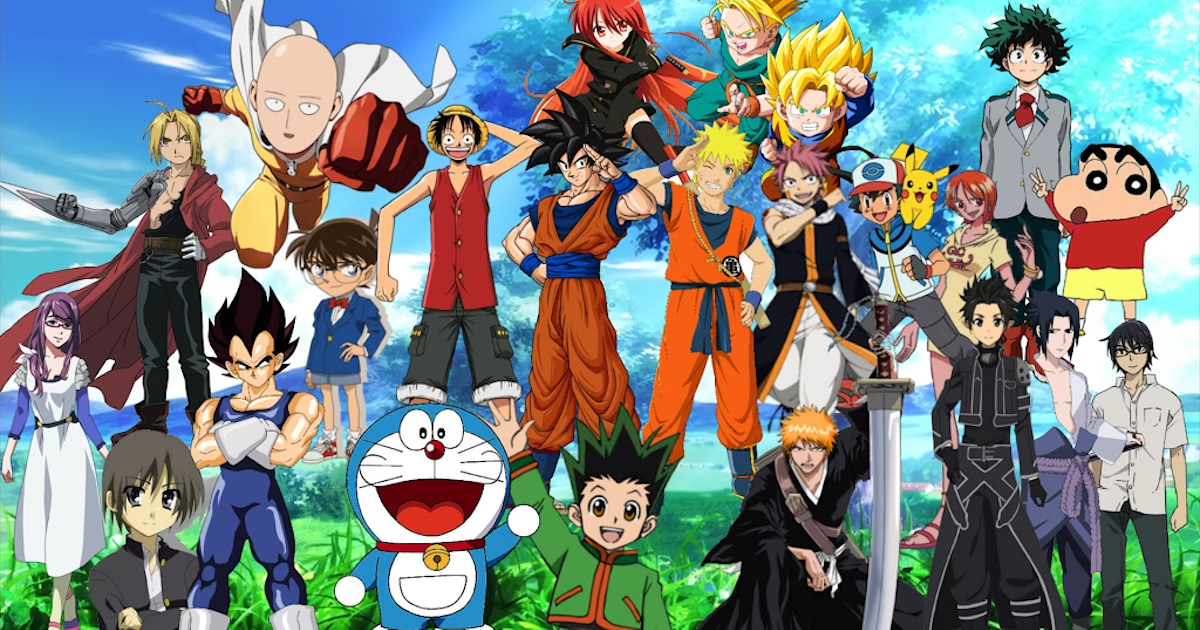Introduction to Manga’s Timeless Journey
Manga, the vibrant and expressive Japanese art form, has captivated readers worldwide with its unique blend of storytelling and art. From its humble beginnings in ancient scrolls to its status as a global pop culture phenomenon, manga’s evolution reflects Japan’s cultural, social, and artistic shifts. In this article, we’ll take you on a journey through manga’s rich history, exploring its roots, key milestones, and its undeniable influence on modern entertainment. Whether you’re a seasoned manga fan or a curious newcomer, you’ll discover why manga continues to inspire millions.
The Roots of Manga: Ancient Beginnings
Early Visual Storytelling in Japan
Manga’s story begins centuries ago, long before the term “manga” was coined. In the 12th century, illustrated scrolls known as emaki told tales of myths, legends, and daily life through sequential art. The Chōjū Giga (Scrolls of Frolicking Animals), often cited as an early precursor to manga, featured whimsical depictions of animals acting like humans, blending humor with artistic expression. These scrolls laid the groundwork for Japan’s tradition of visual storytelling, a core element of modern manga.
Edo Period: The Birth of the Term “Manga”
The word “manga” emerged in the late 18th century, popularized by the renowned artist Katsushika Hokusai. His Hokusai Manga (1814–1834) was a collection of sketches, not narrative comics, but it introduced the term “manga” (meaning “whimsical drawings”) to a wider audience. These woodblock prints, or ukiyo-e, captured everyday life, folklore, and satire, resonating with Japan’s growing literate urban class. Hokusai’s work bridged traditional art with a playful, accessible style that would influence future manga artists.
Kibyōshi: Satirical Comics for the Masses
During the Edo period (1603–1867), kibyōshi (yellow-backed novels) emerged as Japan’s first mass-produced comic novels. These illustrated books combined text and images to satirize society, politics, and culture, appealing to a newly literate urban audience. Their bold humor and social commentary set a precedent for manga’s ability to reflect societal trends, a trait that persists in modern works.
The Meiji Period: Manga Meets the West
Western Influences and Modernization
The Meiji period (1868–1912) marked a turning point for Japan as it opened to Western trade and ideas. British and American comic strips, like Punch and Bringing Up Father, introduced speech balloons and serialized storytelling to Japanese artists. The first manga magazine, Eshinbun Nipponchi (1874), created by Kanagaki Robun and Kawanabe Kyōsai, was inspired by these Western styles but infused with Japanese flair. Though short-lived, it paved the way for manga as a commercial medium.
Kitazawa Rakuten: The Father of Modern Manga
Kitazawa Rakuten, often called the first modern manga artist, revolutionized the medium in the early 20th century. His magazine Tokyo Puck (1905) and newspaper strip Jiji Manga blended Western cartooning techniques with Japanese aesthetics. Rakuten’s work formalized manga as sequential, speech-balloon-driven comics, setting the stage for the medium’s explosive growth.
The Post-War Boom: Manga’s Golden Age
Osamu Tezuka: The Godfather of Manga
No figure looms larger in manga’s history than Osamu Tezuka, often dubbed the “Godfather of Manga.” In the 1940s, Tezuka’s New Treasure Island (1947) introduced cinematic storytelling techniques, with dynamic panel layouts that mimicked film pacing. His iconic series Astro Boy (1952) blended science fiction with deep themes of humanity and technology, captivating post-war Japan. Tezuka’s innovations, like his “cinematographic” style, transformed manga into a storytelling powerhouse.
The Rise of Manga Magazines
The 1950s and 1960s saw the birth of manga magazines like Weekly Shōnen Magazine and Weekly Shōnen Jump. These anthologies serialized multiple stories, catering to diverse audiences with genres like shōnen (for boys) and shōjo (for girls). Their affordability and variety made manga a cultural staple, with titles like Sazae-san by Machiko Hasegawa reflecting everyday Japanese life.
Gekiga: Manga for Adults
In the late 1950s, artists like Yoshihiro Tatsumi pioneered gekiga, a darker, more realistic style aimed at adult readers. Works like Ninja Bugeichō tackled themes of class struggle and oppression, offering a gritty counterpoint to mainstream manga. Gekiga expanded manga’s scope, proving it could be a medium for serious, mature storytelling.
Manga’s Global Expansion: The 1980s and Beyond
The Anime Connection
The 1980s marked manga’s global rise, fueled by its close ties to anime. Series like Dragon Ball by Akira Toriyama and Sailor Moon by Naoko Takeuchi became international hits, first as manga and then as animated series. Anime adaptations amplified manga’s reach, introducing Western audiences to Japanese storytelling through shows like Pokémon and Yu-Gi-Oh!. This synergy turned manga into a transmedia juggernaut.
Otaku Culture and Transnationalism
The rise of otaku culture—dedicated fans of manga, anime, and related media—further propelled manga’s global influence. Japanese pop culture spread through conventions like Anime Expo and Comic-Con, where fans embraced cosplay and collectibles. Scholars like Takashi Murakami argue that manga’s appeal reflects post-war Japan’s cultural anxieties, blending cute (kawaii) aesthetics with complex narratives.
Manga in the West: A Cultural Shift
By the late 1990s, manga had taken root in Western markets, particularly in France and the United States. In France, manga accounted for 55% of comic sales by 2021, driven by series like Naruto and One Piece. Western comics like Scott Pilgrim began adopting manga’s visual style, while Hollywood drew inspiration from works like Akira and Ghost in the Shell. Manga’s influence reshaped global storytelling.
Manga Genres: Something for Everyone
Manga’s diversity is one of its greatest strengths, with genres catering to every demographic and interest. Below is a breakdown of the major manga genres and their defining traits:
| Genre | Target Audience | Key Themes | Popular Examples |
|---|---|---|---|
| Shōnen | Young boys | Action, adventure, friendship | Naruto, One Piece, Demon Slayer |
| Shōjo | Young girls | Romance, drama, self-discovery | Fruits Basket, Sailor Moon |
| Seinen | Adult men | Mature themes, complex narratives | Berserk, Attack on Titan |
| Josei | Adult women | Relationships, career, personal growth | Nana, Honey and Clover |
| Kodomomuke | Young children | Fun, moral lessons, lighthearted stories | Doraemon, Pokémon |
Why Genres Matter
Genres allow manga to connect with readers across ages and cultures. For example, shōnen inspires with tales of perseverance, while josei explores the nuances of adult life. This versatility ensures manga’s universal appeal, whether you’re a teen chasing adventure or an adult seeking emotional depth.
The Impact of Manga on Global Pop Culture
Influence on Film and TV
Manga’s storytelling has left an indelible mark on global media. Films like The Matrix drew inspiration from Ghost in the Shell, while Avatar: The Last Airbender adopted manga’s visual and narrative style. Streaming platforms like Crunchyroll and Netflix have made manga-inspired anime accessible, boosting manga’s cultural footprint.
Fashion and Lifestyle
Manga’s influence extends beyond entertainment. Cosplay, where fans dress as characters, has become a global phenomenon, with conventions drawing thousands. Streetwear brands incorporate manga motifs, blending Japanese aesthetics with Western fashion. This cultural exchange highlights manga’s role as a trendsetter.
Gaming and Beyond
Video games like Final Fantasy and Persona owe much to manga’s art and storytelling. Their vibrant characters and intricate plots mirror manga’s narrative depth. Manga’s influence also reaches music, art, and even education, where it’s used to teach history and social issues.
Pros and Cons of Manga’s Evolution
Pros
- Accessibility: Manga’s affordability and digital platforms make it widely available.
- Diversity: Genres cater to all ages and interests, from kids to adults.
- Cultural Impact: Manga promotes Japanese culture globally, fostering cross-cultural understanding.
- Innovation: Artists continue to push boundaries with new styles and themes.
Cons
- Piracy: Illegal scans threaten artists’ livelihoods and the industry’s sustainability.
- Cultural Misunderstandings: Western adaptations sometimes misinterpret manga’s nuances.
- Market Saturation: The sheer volume of manga can overwhelm new readers.
People Also Ask (PAA)
What is the origin of manga?
Manga traces its roots to 12th-century emaki scrolls and Edo-period ukiyo-e prints. The term “manga” was popularized by Katsushika Hokusai in the 19th century, but modern manga emerged in the 20th century, influenced by Western comics and post-war Japan’s cultural shifts.
How is manga different from Western comics?
Manga is typically read right-to-left, serialized in magazines, and covers a broader range of genres. Its black-and-white art prioritizes storytelling over color, and its cultural roots give it a distinct aesthetic compared to Western comics.
Where can I read manga online?
Platforms like VIZ Media, Manga Plus, and Crunchyroll offer legal manga reading. Free previews are available, but subscribing supports artists and ensures high-quality translations.
What are the best manga for beginners?
Beginners can start with Demon Slayer (action-packed), Fruits Basket (romantic drama), or Doraemon (lighthearted fun). These titles are accessible and showcase manga’s diversity.
Where to Get Started with Manga
Best Tools for Manga Enthusiasts
- VIZ Media: Offers a vast library of translated manga, both digital and print.
- Manga Plus: Free, legal platform with simultaneous releases of new chapters.
- Crunchyroll: Combines manga and anime streaming for a complete experience.
- BookWalker: Ideal for purchasing digital manga with a user-friendly interface.
Tips for New Readers
- Start with Popular Titles: Series like One Piece or Attack on Titan are engaging entry points.
- Explore Genres: Try different genres to find your preference, from shōnen to josei.
- Join Communities: Reddit’s r/manga or local anime clubs offer recommendations and discussions.
- Support Legal Sources: Avoid piracy to support artists and ensure quality translations.
The Future of Manga: Trends and Innovations
Digital Manga and Webtoons
Digital platforms have revolutionized manga distribution, with apps like Manga Plus offering free, ad-supported reading. Webtoons, vertically scrolling comics, are gaining traction, blending manga’s style with mobile-friendly formats. This shift makes manga more accessible than ever.
Diverse Representation
Modern manga embraces diverse themes, like yuri (romance between women) and isekai (another-world fantasies). These genres reflect changing societal norms and attract global audiences seeking fresh narratives.
AI and Technology
AI tools are aiding artists with coloring and background design, but human creativity remains manga’s heart. Virtual reality manga experiences are also emerging, offering immersive storytelling. The industry continues to evolve while staying true to its artistic roots.
FAQ
How did manga become so popular worldwide?
Manga’s global rise stems from its diverse genres, compelling stories, and anime adaptations. The internet and streaming platforms like Netflix amplified its reach, while otaku culture and conventions fostered a passionate fanbase.
Who is the most influential manga artist?
Osamu Tezuka, known for Astro Boy and Black Jack, revolutionized manga with his cinematic storytelling. His influence persists in modern artists like Akira Toriyama (Dragon Ball) and Eiichiro Oda (One Piece).
Can manga be educational?
Yes, manga like Manga Nihon no Rekishi by Shotaro Ishinomori teaches history, while others address social issues like mental health. Schools in Japan use manga to engage students in learning.
Is manga only for kids?
No, manga spans all ages. Kodomomuke targets children, while seinen and josei explore mature themes for adults, covering everything from romance to psychological horror.
Where can I buy physical manga?
Bookstores like Barnes & Noble, Kinokuniya, and Amazon stock manga. Specialty stores like Right Stuf Anime offer extensive collections and merchandise.
Conclusion: Manga’s Enduring Legacy
Manga’s journey from ancient scrolls to a global cultural force is a testament to its versatility and emotional resonance. It’s more than just comics—it’s a window into Japanese culture, a platform for creativity, and a bridge between nations. Whether you’re drawn to the action of shōnen or the introspection of josei, manga offers something for everyone. Dive into a series, explore its history, and join the millions who’ve been captivated by this extraordinary art form. Ready to start? Check out VIZ Media or Manga Plus and let manga’s magic unfold.



